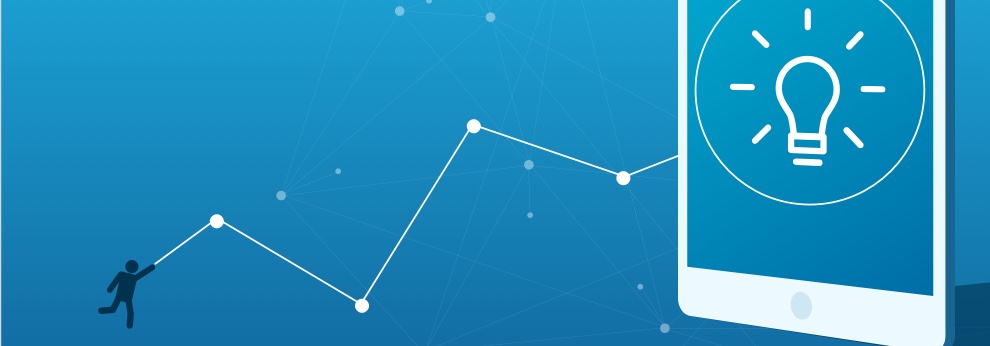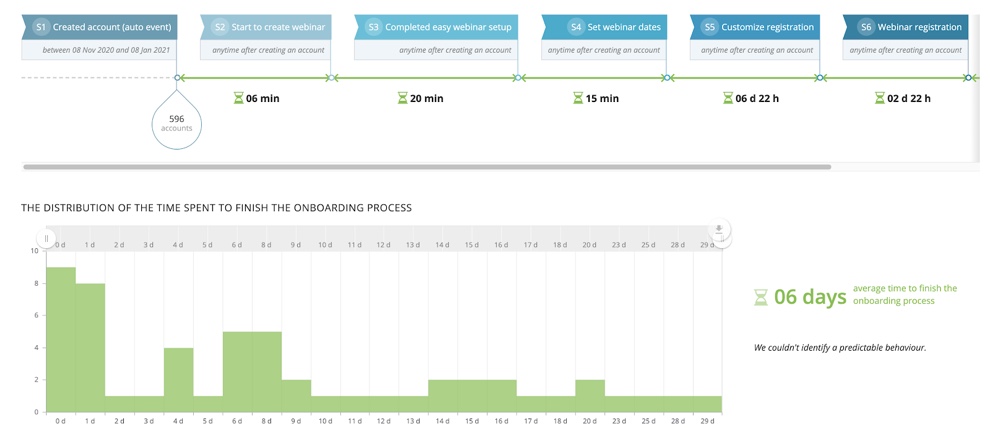How To Double Your Software
Revenue
A growth strategy to 2x revenue using The Rule of 72

Double the Revenue of Your SaaS Company
Download this free eBook and discover the proven system to double the revenue of your business.
Table of Contents
Learn a strategic way to plan, execute and track your progress in order to increase conversions along your unique customer journey in order to double your SaaS revenue.
In this resource we will break down the strategy as follows:
Conclusion: Wrapping Up & Next Steps
Overview
Devising a Growth Plan to Double Revenue
Creating Your Growth Plan Using The Rule of 72
Would you believe me if I told you there was a proven system to double the revenue of your SaaS company?
Imagine for a moment that you had the power to double the growth of your SaaS with just a few tweaks in your business.
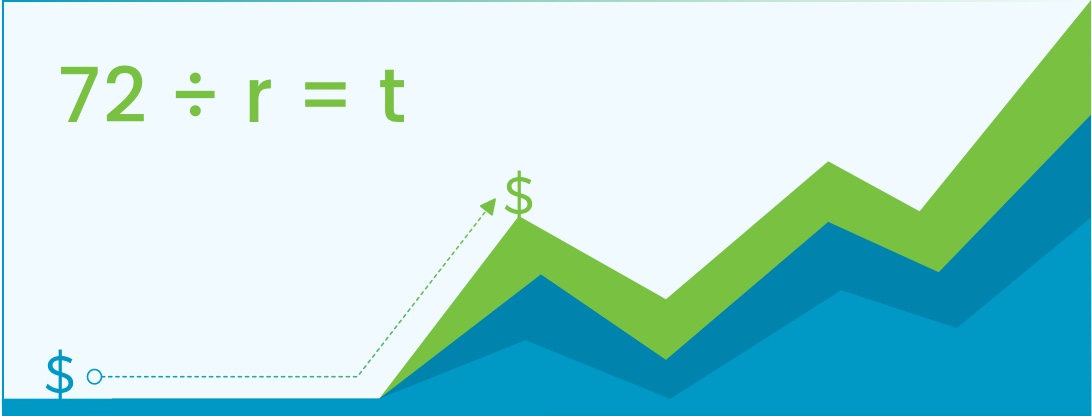
We can understand you might be skeptical, but by the end of the article, we hope to share with you why this math works out. It takes a lot of time and energy to double your revenue. First, you have to find growth opportunities hidden in your product. Then, you have to validate those growth opportunities by collecting accurate data, getting your team on board, and experimenting to determine the best approach.
However, with one simple rule, this process can happen faster and easier than you may initially realize. We’ve seen it work with our clients, and we know it can work with your SaaS business as well.
What is this simple rule we’re talking about? The Rule of 72, a rule of thumb used in business to quickly figure out how many years it would take to double your money through an investment, given the annual rate of return.
The rule of 72 is an approximation, there’s a precise formula for calculating the exact doubling time for an investment earning a compounded interest rate and it’s much more complex, but it's always very close to this rule of thumb.
The equation of the rule of 72 looks like this:
72 ÷ interest rate = Years required to double investment
Assuming your rate of return is 12% year over year, the “Years required to double investment” would equal 72 divided by 12, which turns out to be 6 years.
72 ÷ 12 = 6 Years required to double investment
72 ÷ 12 = 6 Years required to double investment
Quite a bit of time, eh? But since we aren’t looking at an investment like a Venture Capitalist would, we need to hack this rule to make it work for the growth of a SaaS business.
How to Apply the Rule of 72 for a SaaS Conversion Funnel
To growth-hack a SaaS conversion funnel using the Rule of 72, first, we need to change the name of some of the variables in the equation.
Instead of looking at the interest rate, we will be looking at the growth rate and instead of looking at years required to double the investment, we will be looking at the number of steps in a customer’s journey.
The equation then turns into this:
72 ÷ growth rate = Number of steps in a customer’s journey
Once we have our new equation adapted for growth, we need to determine the number of steps on our customer’s journey and solve for the growth rate.
Please note that this strategy will work for any SaaS product with any customer acquisition strategy. But to have the rule of 72 work properly for your business, the equation needs to be adapted to fit the specific journey your customers go through.
In this guide, we will use an example customer journey of a SaaS business to illustrate the technique. For our example, we will map out the customer journey of a software product with a free trial customer acquisition strategy.
There are typically 5 steps in the journey of a customer for this type of SaaS business.
They are:
Step 1: Visits
- From Stranger to Visitor
Step 2: Creates Account
- From Visitor to Sign-up
Step 3: Get Onboarded
- From Sign-up to Onboarded User
Step 4: First Week Retention After Onboarded
- From Onboarded User to Returning to the Product within 1 Week
Step 5: Upgrade to a Paid Account
- From First Week Retention After Onboarded to Paying Customer
Now that we have the five steps, we can reverse engineer the growth rate you need to “hack” your way to doubling your revenue. That calculation looks like this:
72 ÷ growth rate = Number of steps in a customer’s journey
72 ÷ growth rate = 5
growth rate = 72 / 5
= 14.4%
Your growth rate is therefore 14.4%. To keep the math easy though, let’s go ahead and round this number up to 15%. So what does this 15% mean?
This will mean that if you improve your conversion rates by a mere 15% between each step of the customer’s journey, the improvement will compound and you will double the revenue of your business.
It’s worth noting that if you have more or fewer steps in your customer journey, you can adapt your formula as you see fit. For example, if you have 6, 7, or even 8 steps in your buyer’s journey, your tweaks may be smaller but more spread out.
After we’ve identified the steps that a visitor goes through from the moment of discovery to the moment of generating recurring revenue, we can define the customer’s journey.
Let us illustrate what we mean with a funnel of our example. First, we will look at the initial funnel, then we will apply our improvement of 15% to each conversion rate and in the end, we will look at how the compounded improvements of all steps result in doubling the revenue of the SaaS business.
Bonus material: Follow along with our example using this calculator.
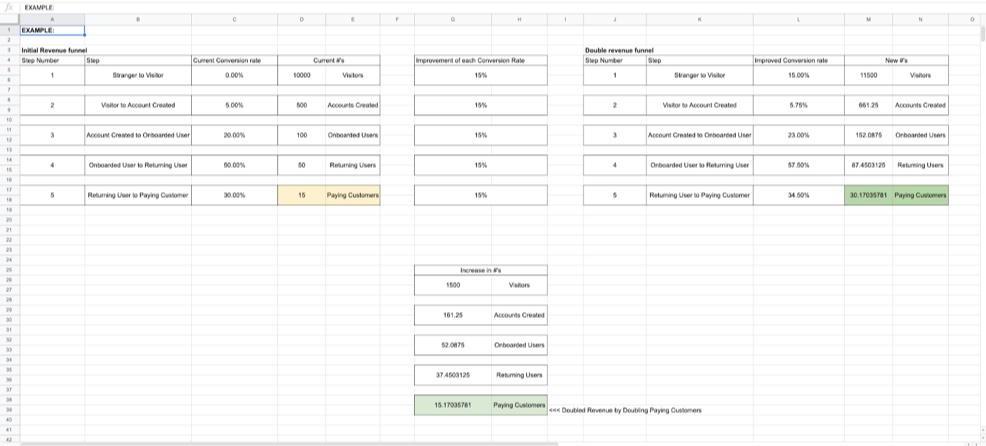
Example Conversion Funnel for Doubling Revenue with The Rule of 72
Initial Conversion Funnel
This is the current funnel with the baselines we are trying to improve.
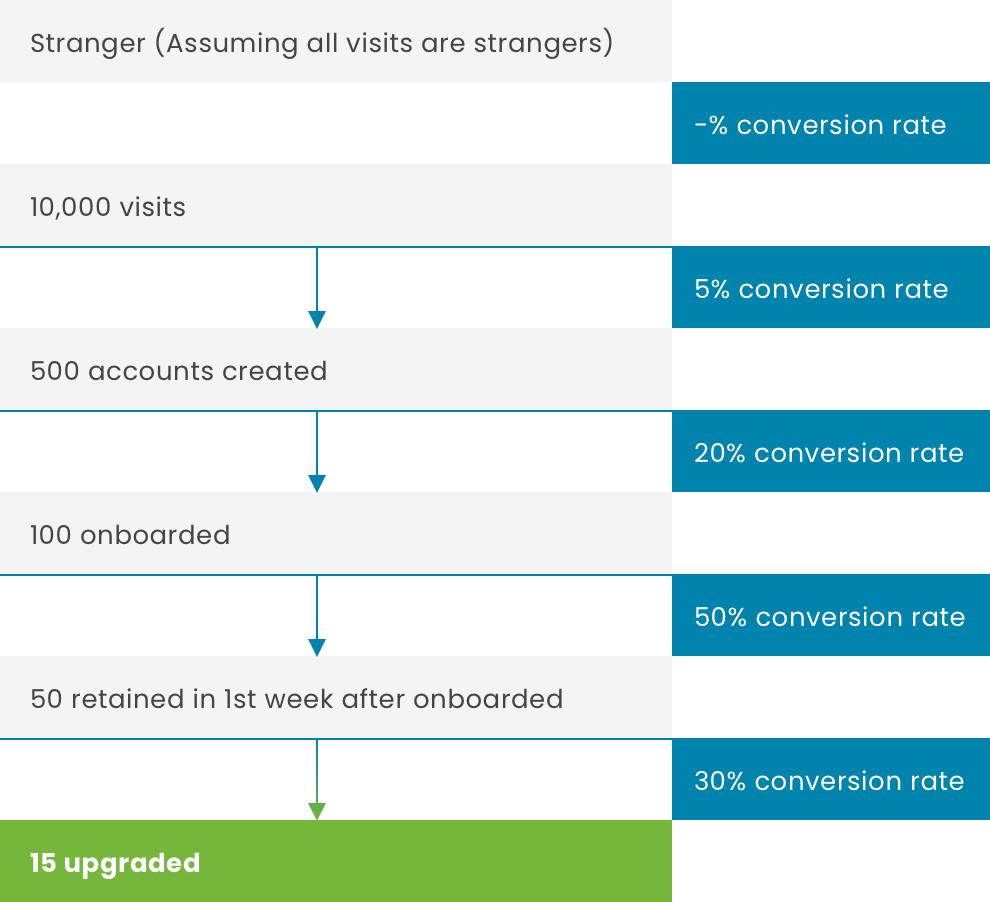
Doubled Revenue Conversion Funnel with 15% Improvements
This is the ideal funnel we want to optimize for, it includes the 15% conversion rate improvements between all of the steps.
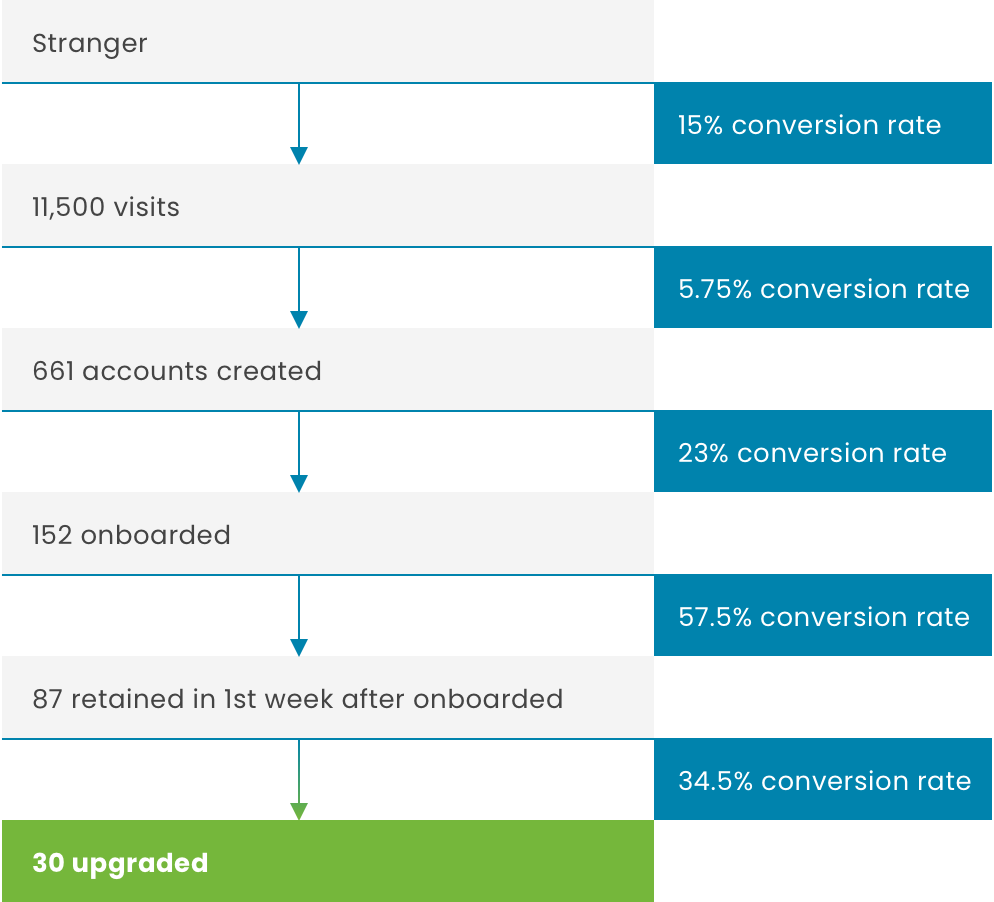
Conversion Funnel Increases
These are the different increases (equivalent to a 15% conversion rate improvement) we need to work towards.
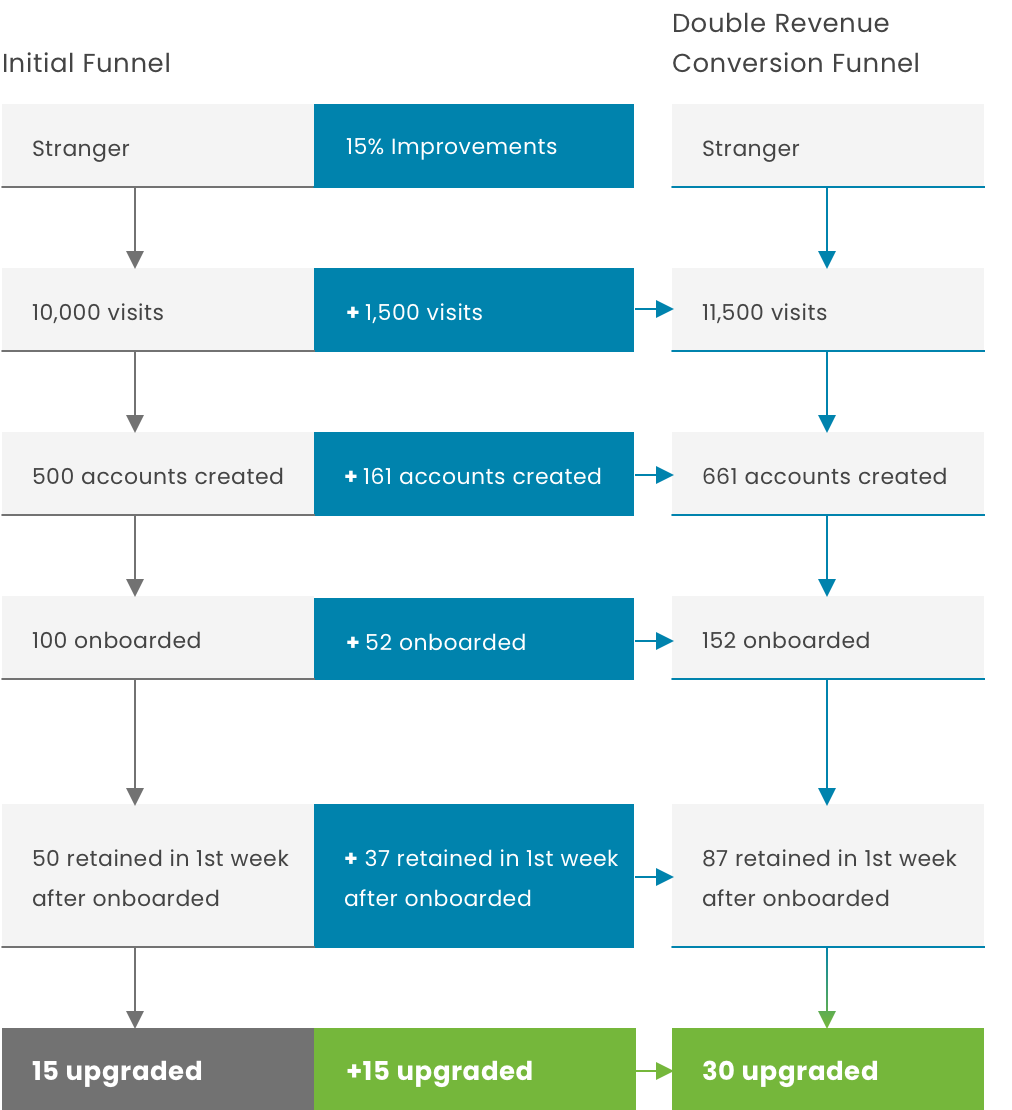
Doubling revenue can be an extremely difficult task to consider, but if you break it down and look at it as optimizing each separate step by a mere 15%, it becomes much more tangible and actionable.
For example, imagine we’ve improved our visits and we now want to move on to improve the conversion rate of the second step by 15%. We need our conversion rate of Visitor to Sign-up to improve just a little bit, from 5% to 5.75%.
If we continue to do these same small improvements for the conversion rate between the remaining steps, we will double the revenue of our business.
See how much more tangible and actionable it is when you have a growth plan like this one? You know exactly what you should be working on to double the revenue of your business.
Tiny changes compound and lead to big results!
To do this correctly for your SaaS product, you’ll need to dive deep into the behavioral analytics of your users. Once you completely understand the behavioral analytics of your product, you’ll have a baseline funnel highlighting where your current bottlenecks are in the customer journey.
From there you will be able to use the rule of 72 to devise a plan for improving the conversion rate of each of the steps in the customer’s journey.
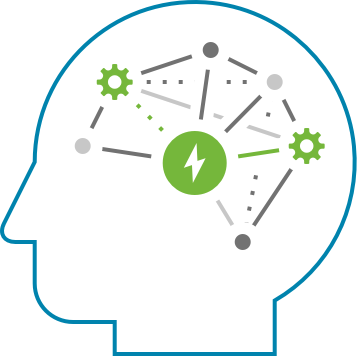
We’ve learned from experience just how complicated behavioral analytics gets, so we want to extend a helping hand. We’ve developed a software product that makes behavioral analytics easier than ever before.
InnerTrends lets anyone get deep insights into how their users behave, without having to be a data expert. Our product will answer the most important behavioral analytics questions of your business for you and point you in the right direction for growth.
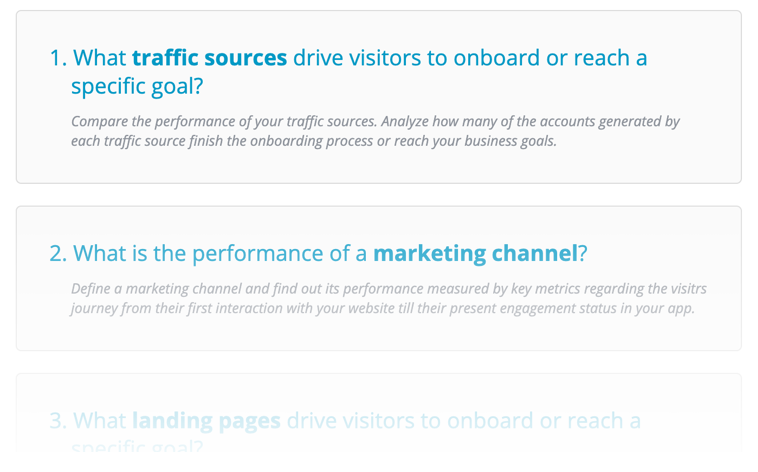
If you’re interested in seeing how our self-service product analytics platform cuts through the noise in your data, feel free to schedule a demo with us by clicking here.
When we look at our goal of doubling our revenue, it’s hard to fathom a growth strategy that would get us there easily. But, when we break this down into a series of smaller, more achievable steps, the goal of making twice as much money feels more like something that can be measured, improved, and reached!
With this in mind, let’s break each of the steps of the customer’s journey down further with some tangible strategies you can use to improve the conversion rates of your SaaS business.
Step 1
Optimize Traffic Growth For Your SaaS Product
We know that finding the next growth opportunity or key insight that will help you reach the growth targets you set in the previous chapter can be challenging.
That’s why we decided to not only teach you how to craft a growth plan to double the revenue of your SaaS product (Chapter 1) but we will also help you discover the growth opportunities at different points of your customers’ journey. So you can follow through with the plan and double the revenue of your business.
This chapter will focus on uncovering growth opportunities for getting more traffic to your site.
Step 1: Visits - From Stranger to Visitor
The 4 Sources of Traffic Growth
The first step in a customer’s journey is getting them to one of your web pages. Whether it’s paid traffic, referral traffic, organic traffic, or social media traffic, the more qualified visitors you can get to your website, the better.
Working with our rule of 72 example, the goal is to improve traffic by a mere 15%. The question then becomes - how can you drive more traffic?
Well, it depends on how you're currently driving traffic to your website. We’ll break down the main 4 sources of traffic and discuss some growth strategies for each to get more people to visit your site.
1. Organic Traffic Growth
Organic traffic encompasses all the visitors who end up on your website from a search engine without you having to pay for ads.
We know that 75% of all search traffic goes to the websites that rank on page one. We also know that 30% of all traffic in a search engine goes to the first link in the search engine result page (SERP).
The best way to improve your organic traffic, therefore, is to improve the search engine ranking of your pages. How do you do this? It all boils down to the proper search engine optimization of your content. If the blog posts, articles, web copy, etc… on your website don’t feature the keywords that people are searching for online, you won’t garner any page views from search engines.
Unfortunately, even if you do use the keywords people are typing into search engines you still could end up on the second page or worse of the SERPs. The cause? competition.
You need more than a single keyword on your post to rank among the top links. That’s why it’s important to understand domain rating, URL rating, what backlinks are, and their importance. With a good understanding of all of these factors, you’ll be able to find the best organic growth opportunities for your website.
Here are three things you could do to improve your rankings and increase your traffic starting today:
Content Gap Analysis
Optimize Current Content
Backlink building
Content Gap Analysis
The best way to gain insights into what will help you grow is to effectively spy on the people outranking you and understand what are the gaps within their content strategy that need to be filled.
One of the most reliable ways to do this is with a content gap analysis, where you take all the keywords your competitor ranks for and subtract the keywords that your website ranks for. What you get is a list of keywords that you should be targeting.
Ahrefs’ Content Gap tool allows doing that with a bunch of competitors at the same time, giving you a massive list of keywords that you should be targeting.
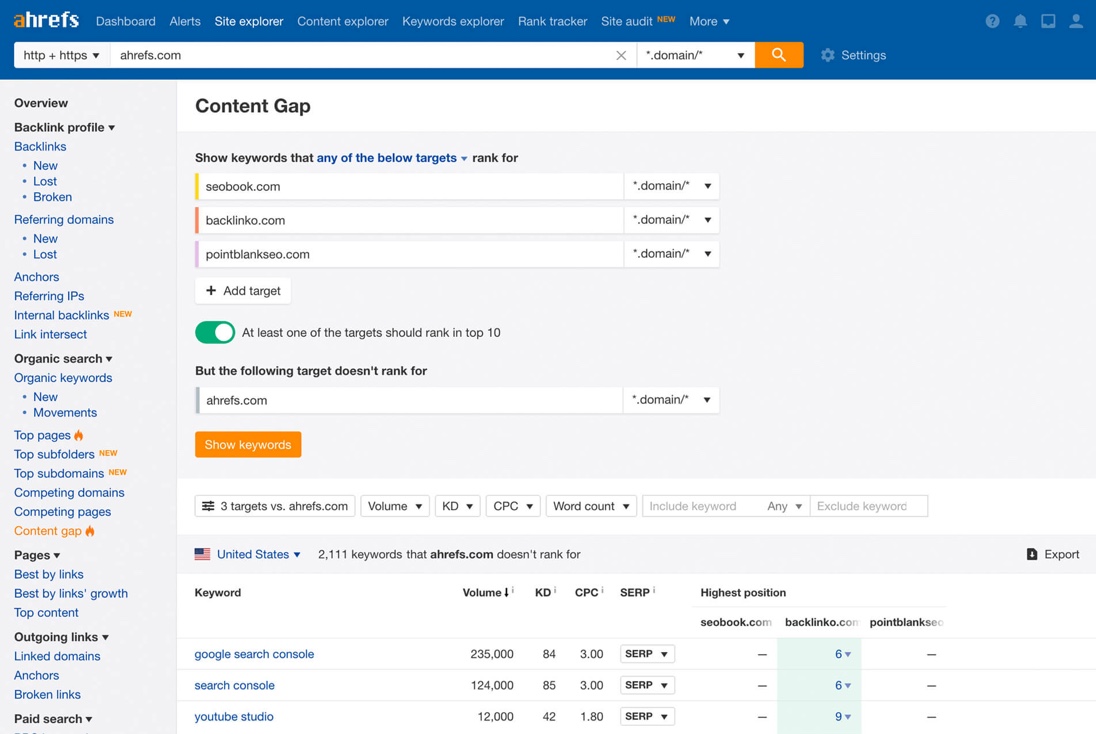
Optimize Current Content
If you already have a modest library of content that isn’t fully optimized, you probably have a great opportunity to increase traffic by simply using the Google Search Console. Here is what you want to keep an eye for:
1.
Identify what keywords is your website ranking for that are close to the first page of results (positions between #6 & #15) and also have a decent number of impressions you can capitalize on
2.
Identify relevant content that is associated with these keywords but isn’t leveraging them on the page currently
3.
Pick the best keyword to optimize your content for. Ideally, look for keywords with a Keyword Difficulty (KD) rank of under 25 (Check out Keyword KD’s for free here https://ahrefs.com/keyword-difficulty)
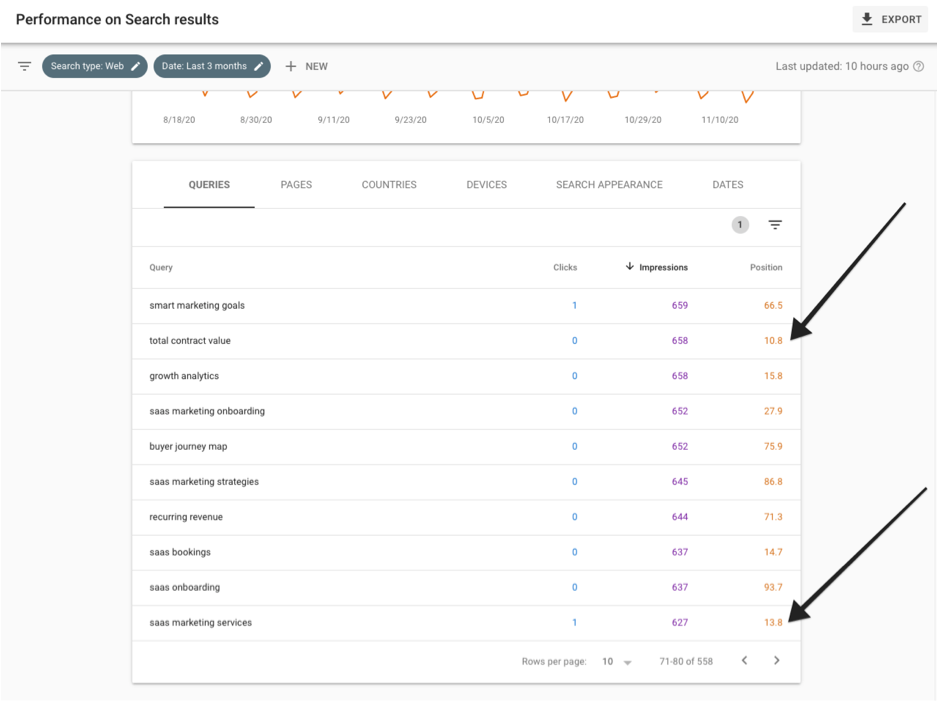
Once these are known you can simply optimize the page to include these relevant keywords and capitalize on ranking opportunities. You should only have to do this for 1-3 pages to reach your goals in general. However, this only works for sites that have content already. Otherwise, they will have to look at paid traffic or referral traffic options.
Building Backlinks
Link building is third on the list because even though it is extremely powerful, it does take a bit of work to get going. There are many backlinking strategies out there, we will outline a basic guide and list some resources along the way that you can use to get started with backlinks.
1.
Do your Backlinks Research:
The most important step to a backlinking strategy is to make sure you do your research correctly. Your findings will dictate how impactful your efforts will be, so make sure not to skip this step. Here are a couple of resources on conducting your research:
2.
Pick a Link Building Strategy:
Here are a few link building strategies you can use to build backlinks to your site:
- Reverse-Engineer Your Competitors - Create better content than your competitor and reach out to the backlinks they have, it’s likely that those who linked to competing content will want to link to your content too (or instead).
- Resources Page Link-Building - Reach out to pages that are a list of resources and try to add your piece of content to their list.
- Guest-Blogging Link-Building - Offer to create valuable content for their blog, and in exchange, ask for a backlink.
- "Guestographic” Link Building (Infographic) - Just like Guest-Blogging, offer them valuable content, only that this time in the form of an infographic. We like to highlight this twist on the previous strategy because infographics are much more likely to be shared between people and easier to link to.
- Broken Link Building - Provide the service of checking for broken links on someone’s website. When you find a broken link reach out to them letting them know they have this problem and position your content as a replacement link that easily solves the said problem.
3.
Make a List of "Likely Linkers” :
Once you decide on your approach you need to build a list of websites that are a good fit for your strategy.
4.
Gather Email addresses from the websites in your list:
After identifying a list of companies that are a potential backlink opportunity, you need to gather their email addresses. You can find this information manually or use B2B SaaS products like hunter.io to scrape email addresses in bulk from websites
5.
Draft Email Campaign:
Depending on your backlink strategy, write the series of emails you plan to send to your list of “Likely Linkers”.
6.
Send Email Campaign
7.
Execute Strategy with Link Building Partners
If you get these organic traffic growth strategies right you will reach the traffic improvement goals you set at the beginning of this guide, and more than likely surpass them.
2. Paid Traffic Growth
Another option to increase the number of visitors to your site is to pay for it. Some businesses are already using paid ads to garner page views. If you want more views, you can optimize your ads through iterative tests, but that will take time. If you want quick results, you’ll need to increase ad spend.
Another way to improve your paid traffic efforts is to look at less expensive options that will yield a better ROI. These days thanks to Facebook ads, Twitter ads, even Capterra and Linkedin Ads many paid traffic options might be less costly than Google ads.
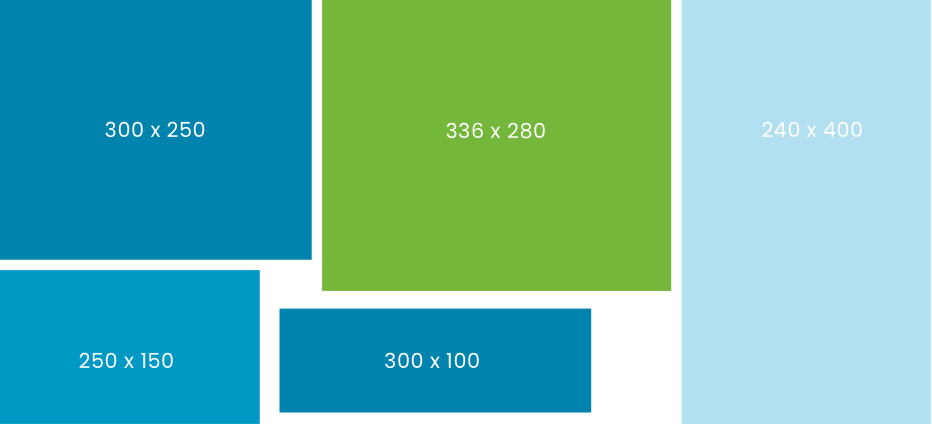
These networks can allow you to stay within budget while generating the required improvement in paid traffic visitors that you need.
Just be cautious as it is very easy to waste money on paid advertising if you are not strategic about it. Make sure to test paid channels first before going all-in on them and you’ll find the right channel for your business.
3. Referral Traffic Growth
This is one of the best types of traffic you can get because it’s built on trust. Essentially, your content gets shared around and more people visit your site because of it.
Your referral traffic will organically grow over time if you are truly putting out valuable content that is worth sharing and not just keyword stuffing.
As a bonus, referral traffic can help your organic traffic reach and backlinking goals as well. That’s why referral traffic and organic traffic often overlap each other - they go together like bread and butter!

4. Social Media Traffic Growth
While social media traffic still is relevant, we’ve found that there is no direct relation between the number of shares and the number of pageviews an article gets. In other words, just because something is shared on social media, doesn’t mean the end-user will click through to read the post in its entirety to learn more.
So what’s the best way to derive page views from a social media share?
Deliver maximum value to your audience instead of pushing for the sale. It’s all about building an engaged audience that waits eagerly for your next post.
The more informative and helpful your content is, the more likely it is for someone to pay attention to your next post and in turn, end up on your website more often.
Using these traffic growth strategies you will surely improve the traffic of your website. So our next strategic move is to improve the sign-up conversion rate as well, in other words getting more visitors to create an account with your product.
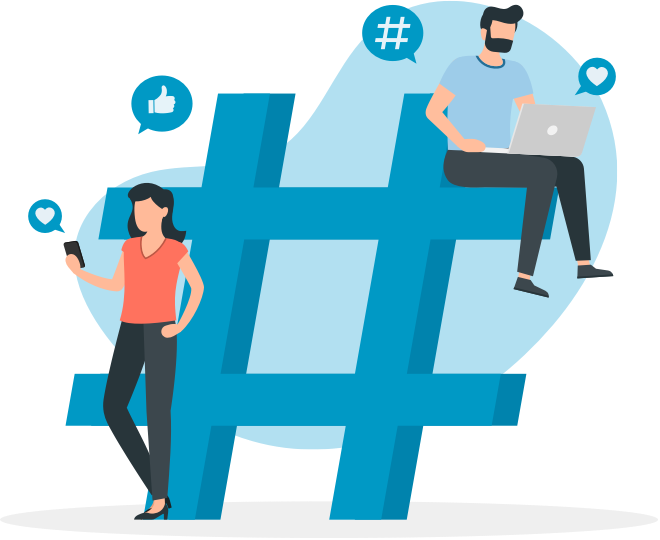
Step 2
Optimizing The SaaS Sign Up Process
Hopefully using the growth strategies from our previous chapter you were able to improve the number of site visitors by 15%!
According to the 5 step growth plan we devised for our example, our next priority is to improve the conversion rate of visitors to sign-ups by 15%. In other words, optimize the signup process.
Step 2: Creates Account - From Visitor to Sign-up
So what’s the best way of doing this? We have 3 strong recommendations:
- Understand your best marketing channels
- Review your sign-up intent pages and sign-up process
- Take a hard look at your signup form
Understanding your Best Marketing Channels
One of the first things we recommend doing is getting a complete understanding of which marketing channels are converting the most visitors into new accounts.
While we are at it, it would be smart to also understand which channels are giving us the most onboarded users and users that upgrade to paid.
By finding your highest performing marketing channels you can pinpoint where your focus should be and can even reverse engineer the journey of successful users to replicate it for the rest of your users.
In InnerTrends we have a one-click report that will tell you exactly this. Check out these two articles that will give you more information on how to find your best marketing channels:
- What is the performance of a marketing channel?
- Marketing Attribution for Software: The Best Multi-Touch Model for SaaS

Once you understand what are your best channels, you can begin to build on top of those and double down on what is working best to reach the improvement you need for your visitors to sign-up conversion rate.
Reviewing Sign-up Intent & The Sign-up Process
The way you present the sign-up form to your visitors and the way you design the signup process can have an initial influence on their decision to not only create an account but even finish the onboarding process and eventually become customers.
Since this step is where you begin to ask visitors for their personal information, the signup conversion is a challenge every SaaS business faces.
Up until this point, the visitors haven’t received anything but a promise, so you have to be very careful about how you approach asking for their personal details.
For example, if your form is unnecessarily long, your visitor won’t bother filling it out.
Finding the best sign-up form will depend on matching the needs of the visitor with those of your business. It will be up to you to balance how much you ask for.
Pro tip: It’s not about the number of questions you ask in your sign-up form but about the context surrounding the questions in relation to what your product does at its core.
For some additional insight we have analyzed the sign-up forms of 40 SaaS companies and broken them down into these 4 categories:
- Short and extra short sign up pages
- Mid-sized sign-up pages
- Multiple-step sign up pages
- Upfront payment details
Optimizing Your Sign-up Page & Form
The way you present the sign-up form to your visitors and the way you design the signup process can have an initial influence on their decision to not only create an account but even finish the onboarding process and eventually become customers.
Since this step is where you begin to ask visitors for their personal information, the signup conversion is a challenge every SaaS business faces.
Up until this point, the visitors haven’t received anything but a promise, so you have to be very careful about how you approach asking for their personal details.
For example, if your form is unnecessarily long, your visitor won’t bother filling it out.
Finding the best sign-up form will depend on matching the needs of the visitor with those of your business. It will be up to you to balance how much you ask for.
Pro tip: It’s not about the number of questions you ask in your sign-up form but about the context surrounding the questions in relation to what your product does at its core.
For some additional insight we have analyzed the sign-up forms of 40 SaaS companies and broken them down into these 4 categories:
-
Short and extra short sign up pages
-
Mid-sized sign-up pages
-
Multiple-step sign up pages
-
Upfront payment details
1. Short and Extra Short Signup Pages
Your typical short signup form looks something like this:
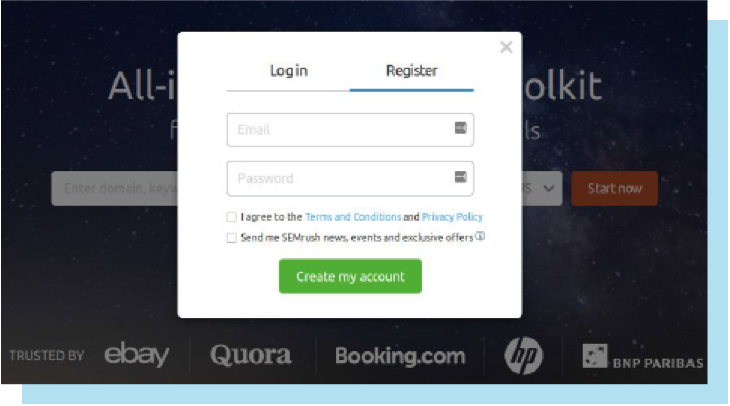
The short and extra short signup pages are designed to collect a large number of leads and are less focused on the quality of those leads.
They are amazing at reducing friction to a minimum. This type of form is best used when the company isn’t in a position to provide a big incentive to convince visitors to provide a lot of personal details.
Growth Strategies To Optimize Short and Extra Short Signup Forms
We recommend you experiment with running multivariate tests of the CTA’s, page layout, and messages that are being shown to the visitor. These will have the biggest influence on a user’s decision to go through this step.
You can also add third-party signup buttons to the form. Visitors may be reluctant to create a new account they need to remember, so letting them automatically create an account through Facebook, Google or Twitter can greatly improve the odds that a visitor follows through with signing up.

If you decide to experiment with adding a third-party signup button, make sure you don’t forget to experiment and identify which of the third-party accounts work best for conversions on your sign up.
2. Medium-Sized Signup Pages
Qualaroo provides us with the perfect example of a medium-sized form:
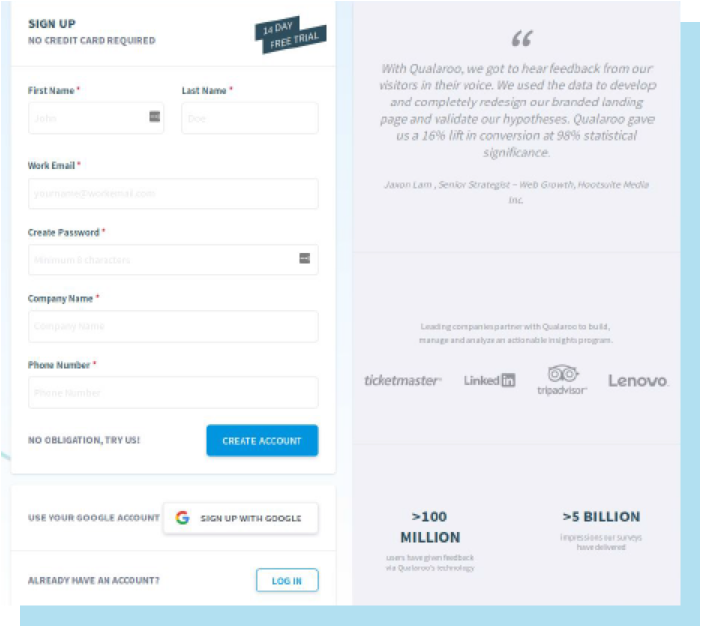
If the purpose of a short signup page is to get a large volume of new accounts, no matter their quality, the objective of the mid-sized form is to get higher qualified leads that are at least a bit interested in using the product.
Visitors will start providing their personal information and filling out the form, only after they become interested in the promise that your landing page has made to them.
Pro Tip: One thing we often notice in medium-sized signup forms is that they often ask for too much information. Be careful with how much you ask for and make sure it relates to the core of your product, not just information you want to collect.
There’s no need to place ten fields in your form if you only need to know four things about your user. Each field in the form only adds to the friction and can influence your visitors’ into abandoning the signup process.
Growth Strategies to Optimize Mid-Sized Sign-up Pages
One idea to optimize mid-size signup pages is to split test form versions. Try to understand what form questions are necessary and even which messaging associated with each question helps convert. It can also be helpful to clearly tell the user the exact reason behind every form field, especially if they may question why it is being asked.
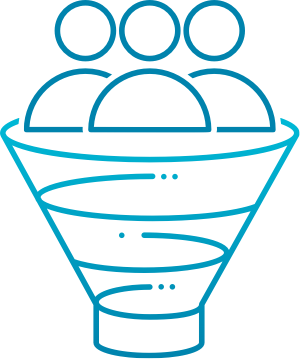
3. Multiple-Step Signup Pages
LiveChat is a great example of a multiple-step signup form:
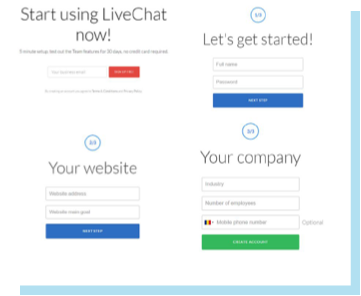
Multiple-step Forms are like a mid-sized form disguised as three short forms.
Pro Tip:Multiple Step Forms are very good at reducing friction because they leave the users somewhat feeling committed to taking the next small step.
The signup forms also allow you to explain in more detail why you need that specific information from your users.
Growth Strategies to Optimize Multi-step Forms
With multi-step forms, it’s smart to treat it like a small funnel and track what steps are causing the biggest drop-off in the sign-up process. By doing so you can identify what are the right steps that are optimal in reducing this drop-off.
4. Upfront Payment Details
Moz provides us with a solid example for this type of form.
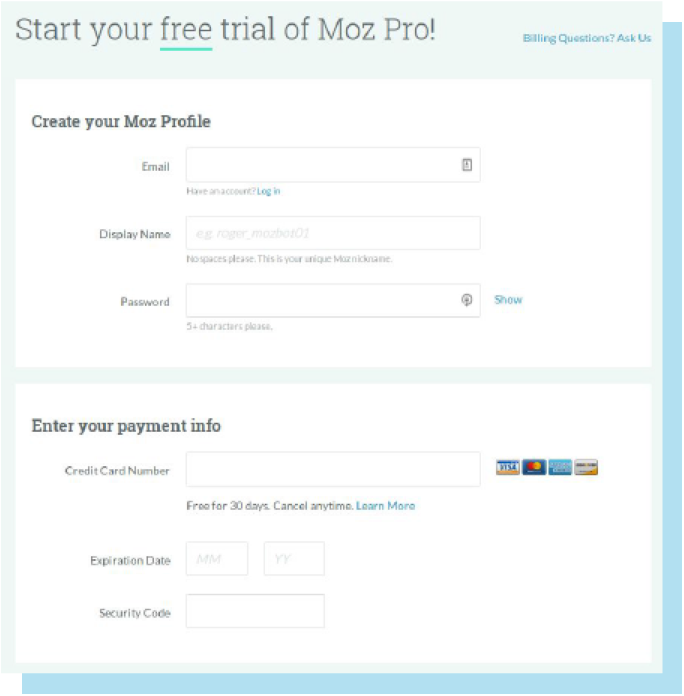
This type of signup form aims to collect leads or users who are strongly committed to using the product.
At InnerTrends we ran an experiment on the pros of Fast vs. Considered Signup. Consider checking it out for more information on this subject.
Pro Tip: In general longer forms that are asking for payment details are mainly used by companies that provide a lot of value from the get-go during the trial period.
Forms that ask for payment details upfront generate the highest amount of friction. That’s why only a person who is committed to using your product would follow through with the signup process.
This type of signup form is mostly used by products that run the risk of free trial exploitation. There have been cases where users keep creating new accounts instead of paying for a service. That’s why it can make sense to ask for payment details upfront.
Growth Strategies to Optimize the Upfront Payment Signup Form
Optimizing this kind of signup form requires providing a very clear explanation to the users of the value they are getting and that they can easily stop the credit card payments at any moment if they wish to do so.
If you plan to ask for your user’s credit card details, you will end up with a long signup form. The best you can do is to make it as clean and clear as you possibly can.

Testimonials are also a great way of increasing trust, they provide reassurance from other users that it’s worth inserting the credit card details.
Pro Tip: Offer a money-back guarantee to help reduce friction on sign up.
Applying these growth strategies to your sign up process will surely improve the visitor to sign up conversion rate of your website.
Our next priority to discuss is how to improve the onboarding conversion rate of those that did sign up. In other words, how do we get more new sign-ups to complete the onboarding process?
Step 3
Improve User / Customer Onboarding & Time To Value (TTV)
We have now improved the first two steps conversion rates in the customer journey and now we have to take a look at the third step.
So what do we do with all those new accounts being created to try our product? Well, make sure that they complete the third step of the customer’s journey, the onboarding process.
In this chapter, we will be looking at growth strategies for improving user onboarding and the percentage of new users that experience the value of your product.
Step 3: Get Onboarded - From Sign-up to Onboarded User
Why is User Onboarding Necessary?
Before we get ahead of ourselves, let’s explore why user onboarding is so important to SaaS products.
The onboarding process is closely related to the other core goals within your product, including retention and revenue. Therefore user onboarding becomes essential to successfully increase the conversion rates of the remaining steps of our growth plan to double revenue.
Watch this video to learn how user onboarding relates to the rest of the core goals within your product.
What is Customer Onboarding / User Onboarding?
At InnerTrends we define the onboarding process as the moment from which a new user creates their account, to the moment when they first experience the promise of your product.
This promise is the value that your product can deliver to users.
Read more about how we look at user onboarding and why successful onboarding ends with a promise.
For many software products, onboarding is where a significant number of potential customers drop-off in the sales process. Therefore, it’s an area that holds a lot of potential for both B2C and B2B software businesses.
So how can you tell if your user onboarding is helping users or making them abandon ship?
The best and easiest way is to use InnerTrends to quickly find out:
- The exact moment users drop off
- The average time it takes a user to complete the onboarding process
- The current onboarding rate of your product
- and other actionable insights
With this data, you will be able to analyze what points in your onboarding process need improvement.
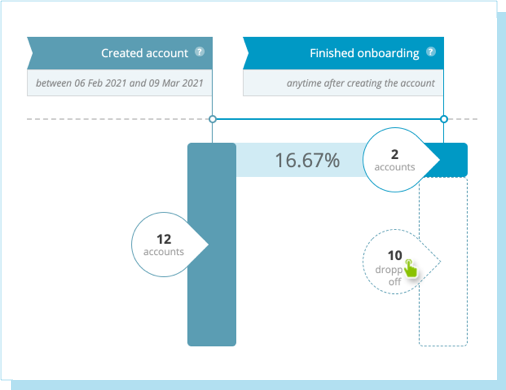
Partial InnerTrends Dashboard
What is TTV (Time To Value)?
No one wants to spend a lot of time or effort setting up and learning a product that might not even do what it promised. Time to value or TTV refers to the time it takes for a user to see the value they were hoping to get from your product.
This is often referred to as TTFV or Time To First Value within the User Onboarding process since this is the first time you get a chance to deliver on the promise of your business.
The goal here will be to streamline TTFV for users in the most optimal way and time. This doesn’t always mean as fast as possible though, so you have to find the right balance.
You can also check out this quick video to learn more:
Optimizing Time To Value
Now that we know that getting to first value is not all about speed, how do we break this down further?
The best way to do this is to begin to understand the time it takes to reach each of the core steps within your onboarding process.
Check out this report from InnerTrends:
With this simple report, we can understand the average time it takes users to navigate our core required onboarding steps.
A report like this can help you optimize your Time To Value by triggering sales and marketing activities at just the right time, to help your users onboard through the most optimal experience.
User Onboarding Optimization Resources
We’ve put together several exceptional resources to help increase your onboarding rate by 15%, make sure to check them out:
Step 4
Improving Your First-Week Retention Rate
In the previous chapters, we talked a lot about the rule of 72 and the small compounding changes you can make to double your revenue. We’ve shared how to increase traffic to your website. We’ve discussed ways to increase your signup conversion rate and your onboarding conversion rate.
By this point, you have done some heavy lifting. Now, we're at one of the most exciting stages in the customer journey - retention. After all, it’s the SaaS business’s ability to retain customers that attracts investors and gives your business the ability to weather most economic downturns. (Kinda important to get this part right!)
The question we’re going to tackle in this chapter is:
How can you improve your retention (first-week retention after achieving onboarded in this case) by a mere 15%?
Step 4: First Week Retention After Onboarded - From Onboarded User to Returning to the Product within 1 Week
There’s a world-famous ice cream spot in Portland Oregon called Salt & Straw. Anyone can get ice cream from any grocery store, yet on any given summer evening (even during the pandemic!), you will find a line around the block, just to get one of these scoops. People keep coming back, waiting in long lines, exposing themselves to some very strange flavors, yet they come back. So what is Salt & Straw doing differently? What makes them so unique?
Well, they aren’t just selling ice cream, they're selling an experience. Whether it's the creation of unique flavors, consistent quality, or a dine-in environment, Salt & Straw is creating an excellent experience that helps potential customer's with their initial taste testing, getting them to explore their flavors more.
Imagine you’ve decided to try the world’s best ice cream, and you’re committed to standing in the very long line. How does Salt & Straw treat this situation? They send their salespeople out into the line to provide tasting samples. By the time you’ve reached the cash register, you already explored and decided on a flavor you want to purchase.
Much like the long line at Salt & Straw, there’s a gap between the onboarded user (someone who has tasted their first sample) and a paying customer (someone who purchased an ice cream).
How your business interacts with a possible customer metaphorically “waiting in line to pay”, is exactly what we mean when we talk about the first-week retention after onboarded. We are not talking about long term retention here, but what users are doing in your software during their free trial before they pay you.
In the terms of the ice cream shop, new users will explore additional samples (product features) during their free trial (long line) to determine what flavors (paid plans) they would enjoy the most, so by the time they reach the end of the line (when their free trial is about to expire) they have explored enough, decided on a flavor, and are ready to make a purchase (upgrade to a paid account).
Shortest Period + Maximum Data
In our ice cream example, there could be 6 flavors of ice cream samples being taste-tested by potential customers in line. Wouldn’t it make sense to analyze which flavors were purchased most that day to determine which ice cream flavors might be purchased more the next day? and also which flavors keep getting customers to come back for more? This is exactly what you should find out for your product.
Using your product analytics tool, focus on analyzing a cohort of users who behave optimally in the shortest amount of time.
Let’s say we have a 14-day free trial. Usually, if a user doesn't come back within the trial period then the first experience wasn't of much value and they’re most likely not going to continue assessing the product any further. To work through this problem you would need to return to Step 3 of 5, the previous chapter on improving user onboarding.
However, if we look at the cohort of users that did return in the first 7 Days after onboarded and their common conversion activity, you will find deep insights into how to get users to come to explore a bit more and eventually upgrade to a paid plan.
You now have your cohort of users. Here is the question you are looking to answer:
What are the top actions this cohort is doing that lead them to come back to the product within the first 7 days after onboarded?
Strike While the Iron is Hot, or While the Ice Cream is Still Cold
In our ice cream example, there could be 6 flavors of ice cream samples being taste-tested by potential customers in line. Wouldn’t it make sense to analyze which flavors were purchased most that day to determine which ice cream flavors might be purchased more the next day? and also which flavors keep getting customers to come back for more? This is exactly what you should find out for your product.
Using your product analytics tool, focus on analyzing a cohort of users who behave optimally in the shortest amount of time.
Let’s say we have a 14-day free trial. Usually, if a user doesn't come back within the trial period then the first experience wasn't of much value and they’re most likely not going to continue assessing the product any further. To work through this problem you would need to return to Step 3 of 5, the previous chapter on improving user onboarding.
However, if we look at the cohort of users that did return in the first 7 Days after onboarded and their common conversion activity, you will find deep insights into how to get users to come to explore a bit more and eventually upgrade to a paid plan.
You now have your cohort of users. Here is the question you are looking to answer:
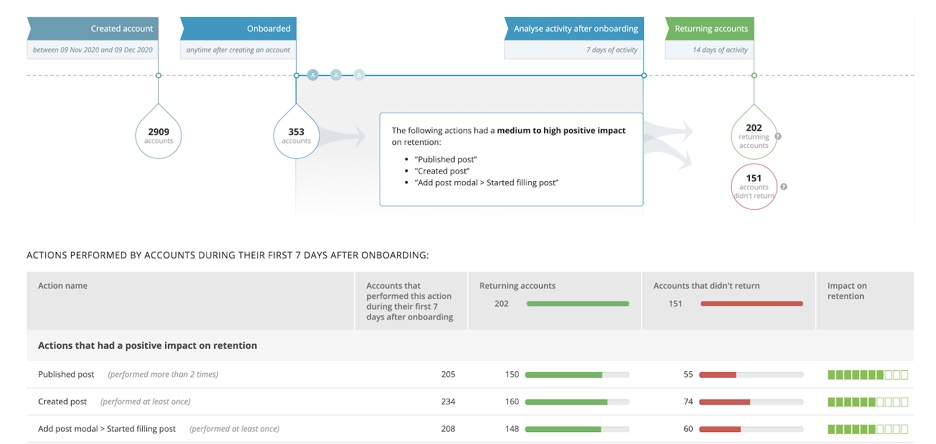
Using this information, you can clearly see which actions have a positive impact on retention after being onboarded. Just a few simple adjustments may be all you need to improve your onboarded to first-week retention conversion rate by 15%.
Growth Strategies for First Week Retention After Onboarded
Here are a few ideas for growth strategies you may want to try inside and outside of your product to increase first-week retention rate after onboarded once you know what actions you are trying to help your users achieve more of:
Leverage Event Trigger Notifications and Emails
Using Intercom or other tools, you can reward “good behavior” or trigger reminders when certain behaviors are not taken. Molding your messages around how users behave.
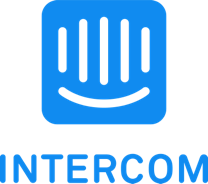
Pro Tip: Triggered emails are one of the most powerful retention tools out there because they allow you to automatically reach out to specific users currently outside of your product in an attempt to get them to come back to explore more.
Experiment with Different Walkthrough Paths
Using tools like Appcues, you can experiment with different guided walkthroughs that help your new users successfully adopt your product. Maybe you’ve identified the most important first 3 user experience steps in your app and it may make sense to experiment with the order of the steps to find the optimal journey for new users.

KLT Campaigns to Build Community
KLT or Know/Like/Trust is a communication strategy that focuses less on the features or capabilities of a product and more on education and personalizing the brand. Here, you’ll think about ways you can educate your user to make their life easier, not on your product but on something else related. Ideally, you’ll be able to relate these helpful articles or emails with the specific steps your happy ice cream eaters are doing.
Step 5
Increasing Upgraded to Paid Account Conversion Rates
So far we’ve discussed how to improve traffic growth, sign-up conversion rates, user onboarding rates, and even retention rates after onboarding. It’s hard to believe but we are on the final step of this guide, and the final step for doubling the revenue of our your SaaS business!
In this chapter, we’re addressing how to improve your conversion rate from First Week Retention After Onboarded to Paying Customers by 15%.
Step 5: Upgrade to a Paid Account - From First Week Retention After Onboarded to Paying Customer
Growth Strategies for First Week Retention After Onboarded
Do you know on average how long it takes for your users to become paying customers?
Let’s take a look at our SaaS product example with a 30-Day free trial period.
If you start by figuring out how much time it takes your new users to become paying customers then you can confidently know when to trigger events that help the upgrading process run smoothly.
In InnerTrends we have a quick report that answers the question:
How long does it take for accounts to reach the goal of “upgraded to paid”?
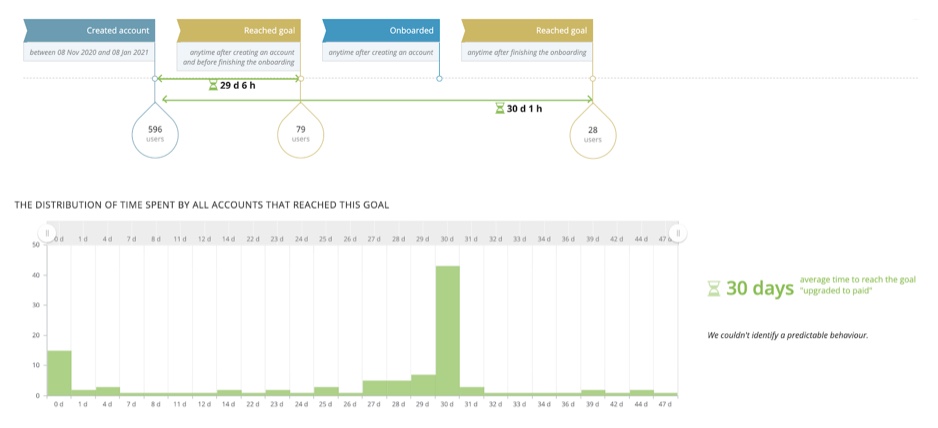
Thanks to the report above we know that on average it takes about 30 days for a new user to become a paying customer. It’s worth noting that the trial period of your product doesn’t always map out specifically to the average time it takes for a new user to become a paying customer, so make sure to find out what yours is.
Growth Strategies for First Week Retention After Onboarded
After discovering how long it takes for a new user to become a paying customer, we need to dissect the journey further by looking at the amount of time we have to work with, so we can then optimize this final step’s conversion rate.
To find out how much time we have to work with we first need to know three bits of information, luckily, we already know two of them:
- First-week retention after onboarded (7 days after Onboarded)
- The average time it takes for a new user to become a paying customer (30 days)
- The average time it takes for a new user to become Onboarded (Unknown)
That being said, we need to know how long it takes for users to become Onboarded. We talked about this a bit in Step 3 when we discussed improving user onboarding, but we mostly focused on the time it takes to reach each specific onboarding step.
For the analysis this time around we need to look into the average time it takes for a new account to complete all of the onboarding steps.
In InnerTrends we have a ready-to-go report that looks like this:
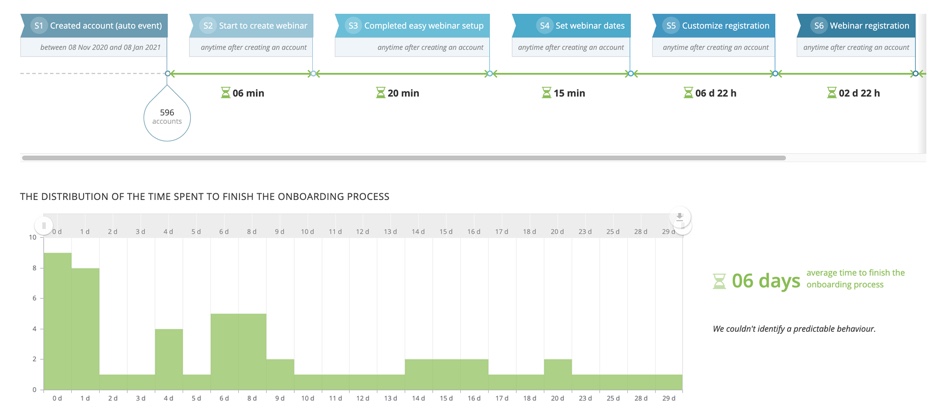
We can see in the bottom right of the image that it takes about 6 days to reach the last step in the Onboarding process.
With our three bits of information we can now paint the bigger picture of what we need to analyze:
- The average time a new user takes to complete the onboarding process: 6 Days
- First Week Retention After Onboarded: 7 Days
6 + 7 = 13 Days Total
- The average time it takes for a new user to become a paying customer: 30 Days
If we take the 30-Day average and subtract 13 days to achieve first-week retention after onboarded we are left with 16 days. So, to improve our conversion rate from First Week Retention after Onboarded to Paying Customers, we know we need to optimize the experience of users from day 16 to day 30 within our example trial period.
Once again, Common Conversion Activity can help
You should already know your common conversion activity from step 4, but let’s reiterate that a little because it comes into effect nicely once you know how long it takes for new users to become paying customers.
We need to answer one question that can be difficult to answer.
What are the differences in actions between onboarded accounts that return and those that churn (activity churn, not revenue or customer churn)?
Additionally, we need to analyze the accounts showing activity in the first 7 days after Onboarded but also the accounts that return to the product within 14 days of being onboarded.
Analyzing this period will highlight insights into what are the common conversion activities that bring accounts back to your product from the 7th day after account creation through the 31st day.
This is a pretty complex algorithm, luckily InnerTrends has this report out of the box ready-to-go:
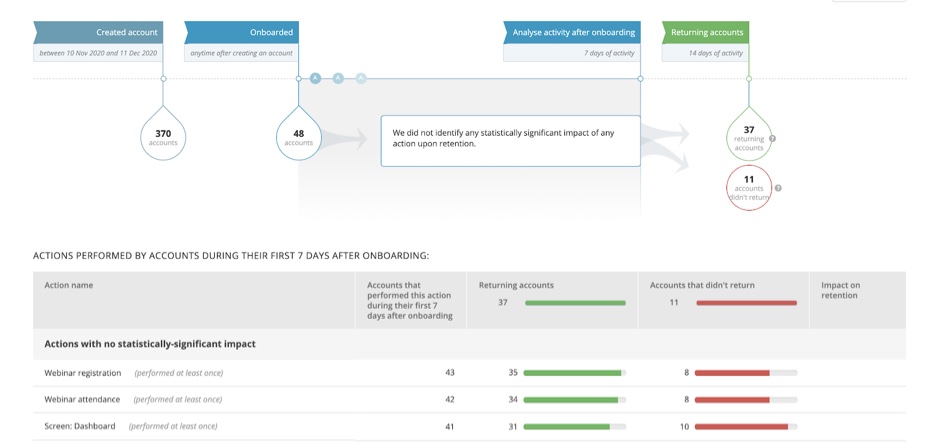
By analyzing the actions performed that create a positive impact on bringing the accounts back to the product, we can start to understand the areas of the product that matter most to accounts at this stage.
However, if we want to optimize the conversion rate from First Week Retention after Onboarded to Paying Customer we need to also understand what specific events or actions lead accounts to churn (activity churn), or not return to the product in this time period.
By knowing this we can begin to try to keep users from experiencing negative events in the product and reach out to users proactively to guide them in experiencing the positive impact areas of our product. In other words, we help them avoid the bad in our product and guide them through the good in our product.
Now I know that what we just went through was kinda a rough one because it’s some deep analysis, but it’s extremely powerful! Because now you can time your messages in such a way that streamlines the journey of a user becoming a paying customer.
Initiating Timely Contact
With strategic and well-timed messages, you can guide users more effectively into the actions that will help them make up their mind about your product.
For instance, you can send them:
- Emails to experience a part of the product they haven’t seen
- Walkthroughs that guide users through an exploration of your product
- Reminders in case they start to order but don’t complete the purchase
- Incentives so they finish the purchase process
- An email giving them the option to pay using alternative payment methods
The types of marketing activities you can set up are endless once you know how you should be timing your engagements and what are the common conversion activities that lead to a paying customer.
Don’t Play Hard to Get: Make Paying You Easy
It’s worth mentioning that SaaS companies often obstruct potential accounts from buying from them by making it hard to complete the payment process.
For example, if a product does not accept Paypal as a payment method and clients don’t want to risk using their credit cards directly, the transaction is abandoned.
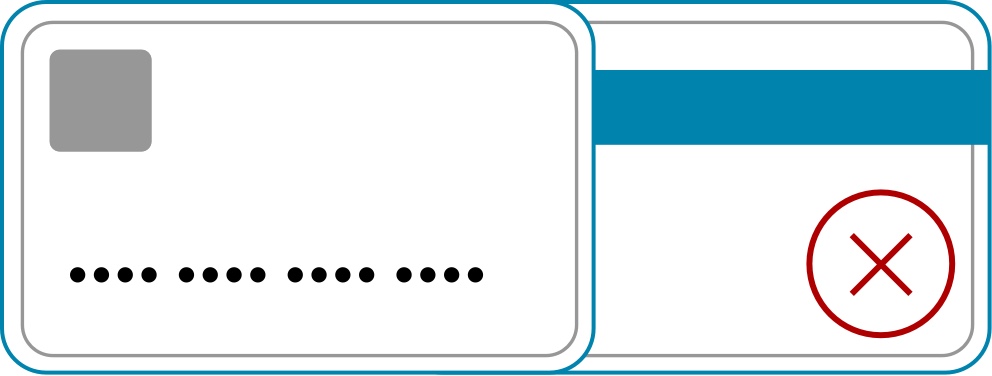
Switching payment providers within your platform is often not an easy feat, but using new payment providers in your email campaigns is much easier. Based on the results you get from such implementations you can take a data-driven decision on which provider works best for the rest of your business.
We have encountered many cases where a simple switch between payment providers did the trick, and the companies are able to get an improvement of 15% or more in the conversion rate of their last step.
Strategic SaaS Pricing Updates
One other important opportunity to consider is pricing strategies.
There are many resources available on optimizing your SaaS Pricing Model but here are a few basics to consider.
Understand Your Value Levers
Rather than marking-up your prices by 15%, take a closer look at your pricing value levers. Do your value levers align with the goals of your users or are they only focused on benefiting your bank account? Shift your focus on aligning your packages with the needs and current situation of your possible customers.
Update Your Tiers
Don’t be afraid to experiment with your pricing tiers. Discover your price elasticity and how it affects your ideal customers. You may find out that the lower tier deal is too low or that you can increase prices among your top tier.
Address User Anxiety
You may be familiar with the theory of the 4-forces why consumers switch. The most important of these forces is often the most overlooked on pricing pages, Anxiety. Anxiety is an anticipatory fear that tells people NOT to try the new solution because (A) it might not actually help us or (B) once we buy into the solution, it won't hold up its end of the bargain. The user might simply be Anxious about their own ability to take full advantage of the investment, for example, video editing software where there’s a steep learning curve needed just to get started.
Wrapping Up
This guide was no small feat, so if you have made it to the end, congratulations! Let’s take a quick look at how we managed to get the example free trial SaaS product to double its revenue.
We first started with an initial conversion funnel that looked like this:
Initial Conversion Funnel

We then crafted a growth plan by utilizing the rule of 72, we calculated that we need to improve all the conversion rates between the steps of our customer’s journey by 15%.
Finally, we discussed growth strategies for all of the 5 steps in the customers’ journey from our example SaaS product. By implementing those growth strategies our example SaaS product ended up with a funnel that looked like this:
Conversion Funnel with 15% Improvements

Thanks to the compounding effect of these tiny improvements, the revenue of our example doubled.
In Conclusion
The goal of this guide was to show you that with simple tweaks, you can see impactful results. So to close this out, here’s what we’d like you to remember:
First, to double your growth you don’t have to double your team, your budgets, or the time you spend on your business. To double your growth, you just need to improve your conversion rates in between each of the steps of your customer journey by a tiny bit.
It’s hard to believe at first, but the compounding effect of small improvements can lead to tremendous results. Small steps will take you to your destination every time!
Secondly, if you have more steps in your customer journey, you can adapt The Rule of 72 formula as you see fit. If you have 6, 7, or even 8 steps in your buyer’s journey, that’s fine too, your conversion rate improvements will be smaller but there would be more steps to improve.
While we’ve covered a lot in this guide, believe it or not, we can help you even more in your journey to doubling the revenue of your SaaS company.
If you're looking to get deep insights into how your customers use your product, InnerTrends can help. Our software will dig into your data, cut through the noise, and deliver ready-to-use reports highlighting your most important growth opportunities. The best part? You won't have to be a data scientist to discover your best growth opportunities for your business, so you’ll be able to focus more on growing your business and less on tedious data tasks.
Experience the power behind our truly self-service product analytics tool, schedule your free InnerTrends demo today!
Learn how InnerTrends can help you solve your biggest growth challenge by transforming raw data into actionable insights.
© InnerTrends 2022
